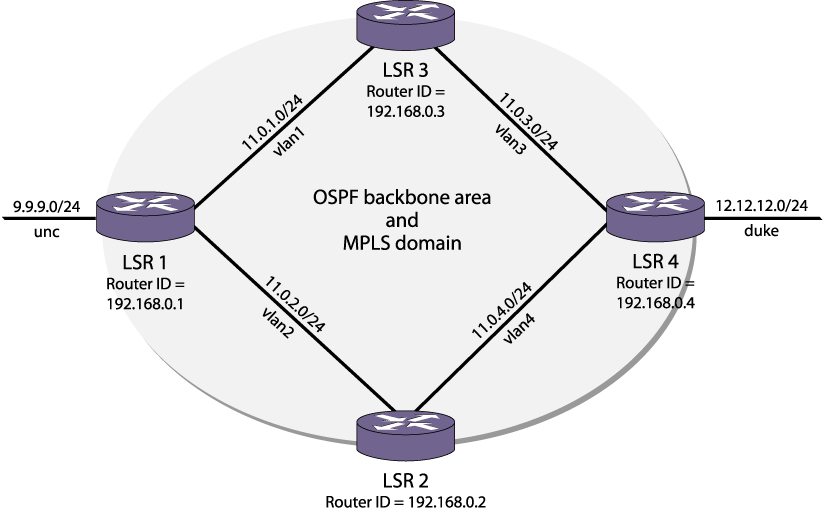The network configuration, shown in MPLS Configuration Example, illustrates how to configure a BlackDiamond switch to support a routed MPLS network.

The four switches, labeled LSR 1, LSR 2, LSR 3, and LSR 4, have the same physical hardware configuration. Each switch contains two 8900-G48T-xl and an 8900-MSM128 module. The switches are all interconnected via Gigabit Ethernet to form the OSPF (Open Shortest Path First) backbone area and the MPLS domain. In this example, two directly connected OSPF-disabled VLANs are shown: unc and duke. Traffic between unc and duke follows routed paths over calculated LSPs established between LSR 1 and LSR 4.
The commands used to configure LSR 1 are described below. The remaining LSRs are configured similarly.
The following commands configure the module types for specific slots:
configure slot 2 module 8900-G48T-xl configure slot 2 module 8900-G48T-xl
The following command sets the maximum jumbo frame size for the switch chassis to 1600:
configure jumbo-frame-size size 1600 enable jumbo-frame ports all
The following commands create the VLANs:
create vlan lpbk create vlan vlan1 create vlan vlan2 create vlan unc
The following commands configure the VLAN IP address and assign ports participating in each VLAN:
configure vlan lpbk ipaddress 192.168.0.1/32 enable ipforwarding lpbk enable loopback-mode lpbk configure vlan default delete ports all configure vlan vlan1 ipaddress 11.0.1.1/24 configure vlan vlan1 add port 3:2 untagged configure vlan vlan2 ipaddress 11.0.2.1/24 configure vlan vlan2 add port 3:3 untagged configure vlan unc ipaddress 9.9.9.1/24 configure vlan unc add port 3:4 untagged
The following commands enable IP forwarding on the configured VLANs.
The MTU size is increased on the MPLS VLANs to accommodate the MPLS shim header:
enable ipforwarding vlan vlan1 configure ip-mtu 1550 vlan vlan1 enable ipforwarding vlan vlan2 configure ip-mtu 1550 vlan vlan2 enable ipforwarding vlan unc
The following command configures the MPLS LSR ID:
configure mpls lsr-id 192.168.0.1
The following commands add MPLS support to VLANs lpbk, vlan1, and vlan2:
configure mpls add vlan lpbk configure mpls add vlan vlan1 configure mpls add vlan vlan2
The following commands enable MPLS on VLANs lpbk, vlan1, and vlan2 and LDP on VLANs vlan1 and vlan2:
enable mpls lpbk enable mpls vlan1 enable mpls vlan2 enable mpls ldp vlan1 enable mpls ldp vlan2
The following command allows LDP to advertise a label mapping for the LSR ID:
configure mpls ldp advertise direct lsr-id
The following commands globally enable LDP and MPLS on the switch:
enable mpls protocol ldp enable mpls
The following commands add lpbk, vlan1, and vlan2 to the backbone area.
The 0.0.0.0 (backbone) area does not need to be created because it exists by default:
configure ospf add vlan lpbk area 0.0.0.0 configure ospf add vlan vlan2 area 0.0.0.0 configure ospf add vlan vlan1 area 0.0.0.0
The following command enables distribution of local (direct) interfaces into the OSPF area:
enable ospf export direct cost 10 type ase-type-1
The following command configures the OSPF router ID on the switch and enables the distribution of a route for the OSPF router ID in the router LSA.
Originating the router ID as a host route allows other routers in the same OSPF area to establish calculated LSPs for external routes to this router:
configure ospf routerid 192.168.0.1
It also allows this router to be a peer in a L2 VPN.
The following command enables OSPF:
enable ospf

 Print
this page
Print
this page Email this topic
Email this topic Feedback
Feedback